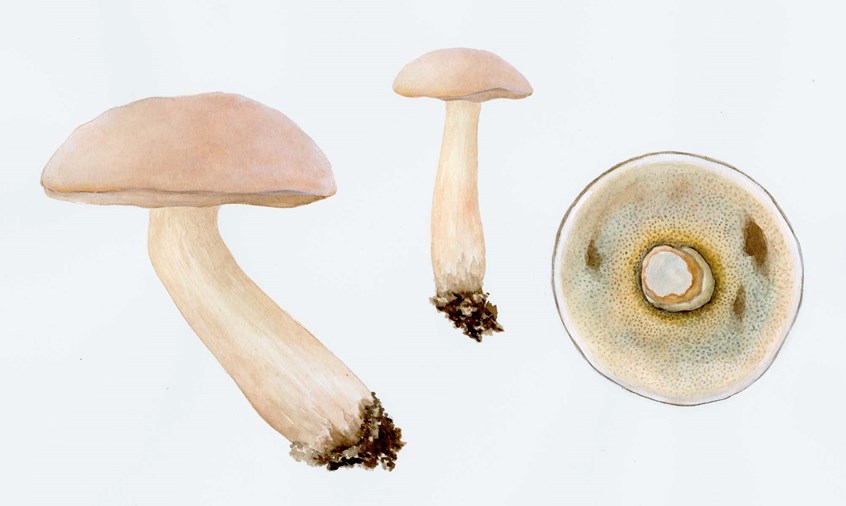Mycology is a branch of biology that studies the genetic and biomedical properties of fungi, defining the taxonomy of organisms on the basis of shared characteristics. While some species of fungi are edible or have medicinal properties, others are highly poisonous. As the differences in visual appearance between edible or medicinal fungi and poisonous fungi are often minute, the ability to develop mycological illustrations is a highly-technical skill. The following graphics by natural science illustrator Joan Thomson highlighting varying species of fungi were created for environmental education materials, contracted projects, and notecard designs.
Boletus Subvelutipes – This bolete fungus of the Boletaceae family is found in Asia and North America. It can be identified by its brown to reddish-brown cap, stem covered by furfuraceous, and bright blue staining that occurs when the mushroom’s flesh is cut. Boletus Subvelutipes fruit bodies are poisonous, producing symptoms of gastrointestinal distress if consumed.
Laetoporus Sulphureus – This species of bracket fungus is found in Europe, North America, and South America. Its fruit bodies grow on tree trunks and branches as golden shelf-like structures stacking themselves in overlapping clusters. When Laetoporus Sulphureus fruit bodies grow old, they fade into pale beige or grey color. Unlike many other bracket fungi, the Laetoporus Sulphureus is edible before it matures.
Clitocybe Nuda – This species of the Tricholomataceae family, also referred to as wood blewit, is native to Europe and North America. The mushroom’s stem can range from lilac to pink in color, topped with a wavy cap usually brownish to dull purple in color. Wood blewits are edible, but they need to be picked with caution due to their visual similarity to other fungi species that are highly toxic.
Amanita virosa – Also known as the “destroying angel,” this species is one of many in the genus Amanita. Found in Europe, the cap of an Anamanita Virosa first appears with a white egg-shaped object on its stem, becomes conical with inturned edges during later stages of development, and eventually becomes flat and hemispherical during the fruit bodies’ final stage of development. While this species closely resembles many edible mushrooms, the “destroying angel” is deadly poisonous.
Trametes versicolor – This common polypore mushroom, nicknamed “the turkey tail” can be found throughout the world. Frequently found on dead hardwood logs and stumps, this species’ velvety caps tend to stay in the brown, cinnamon, and reddish color range. The carbohydrate polysaccharides present in Trametes Versicolor is thought to be useful as an adjuvant in the treatment of gastric, esophageal, colorectal, breast, and lung cancers.
Transmuting the meticulous characteristics of diverse mycological species indicates both a highly-technical background in illustration and an intuitive understanding of the preciseness required to communicate such a detail-oriented branch of natural science. The careful attention to detail demonstrated in these illustrations signifies Joan Thomson’s aptitude for translating scientific accuracy.
Thomson holds a Bachelor of Fine Arts from Syracuse University, a Master of Arts in Education from the University of Kentucky, and has worked as a medical illustrator at Dartmouth Medical School (now the Geisel School of Medicine) for nineteen years. She volunteers with the New England Wildflower Society, is a member of the Guild of Natural Science Illustrators, and a member of the Cardigan Mountain Art Association. View Joan Thomson’s portfolio to check out more of her artwork samples.













